IB Geography/Extreme environments

This theme studies two types of extreme environment:
- Cold and high-altitude environments (polar, glacial areas, periglacial areas, high mountains in non‑tropical latitudes)
- Hot, arid environments (hot deserts and semi‑arid areas)
Challenging Environments
[edit | edit source]Global Distribution
[edit | edit source]Explain the global distribution of each of the two kinds of extreme environment
[edit | edit source]The distribution of cold and high-altitude environments
[edit | edit source]
Cold and high-altitude environments are generally found along constructive plate margins, where fold mountains form, or polar regions. Mountainous regions have a high elevation, where atmospheric pressure is lower which causes lower temperatures. The sun's rays are received more easily however more solar radiation is reflected due to the high reflectivity of snow. At higher latitudes less heat penetrates the atmosphere as it is thicker and spread across a greater area.
The distribution of hot environments
[edit | edit source]
Hot, arid environments are found in the tropics. These areas receive direct sunlight in summer and winter. Hadley cells in the atmosphere also cause aridity as the warm moist air rises from the equator. This condenses and precipitates and the cooler air sinks over the tropical latitudes. The air is drier as cool air cannot hold as much moisture. The air then heats as it spreads over tropical regions and rises again. Hot, arid climates can also be found in rain shadows, mountainous regions with arid areas behind them. The mountains cause relief rainfall and then the dry air blows across the landscape drying it out.
Describe the relief and climatic characteristics that make these environments extreme. Explain how these characteristics present challenges for resource development and human habitation.
[edit | edit source]Population
[edit | edit source]Physical Characteristics
[edit | edit source]Glacial Environments
[edit | edit source]Peri-glacial Environments
[edit | edit source]A periglacial environment is a place where the temperature is seasonally below the freezing point. but never covered by ice. They have a layer of permafrost on or below the surface. Periglacial environments form where it is below 0° C for a significant amount of the year. These areas can be found:
- at high latitudes, for example the northern parts of Asia, North America and Europe
- at high altitudes, for example Tibetan plateau in Asia
Hot, arid environments
[edit | edit source]Opportunities and Challenges
[edit | edit source]Agriculture
[edit | edit source]Opprtunities:
1. nomadism (the traditional way of dealing with insufficient amounts of rainfall and pasture)
2. irrigation in areas close to rivers or oases
3. increased use of drought-tolerant species
4. irrigating with silt-laden river water to restore soil in badly eroded areas
5. land enclosure to reduce wind erosion.
